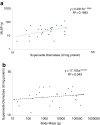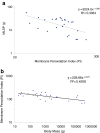A comparative cellular and molecular biology of longevity database
- PMID: 22836712
- PMCID: PMC3776122
- DOI: 10.1007/s11357-012-9458-y
A comparative cellular and molecular biology of longevity database
Abstract
Discovering key cellular and molecular traits that promote longevity is a major goal of aging and longevity research. One experimental strategy is to determine which traits have been selected during the evolution of longevity in naturally long-lived animal species. This comparative approach has been applied to lifespan research for nearly four decades, yielding hundreds of datasets describing aspects of cell and molecular biology hypothesized to relate to animal longevity. Here, we introduce a Comparative Cellular and Molecular Biology of Longevity Database, available at ( http://genomics.brocku.ca/ccmbl/ ), as a compendium of comparative cell and molecular data presented in the context of longevity. This open access database will facilitate the meta-analysis of amalgamated datasets using standardized maximum lifespan (MLSP) data (from AnAge). The first edition contains over 800 data records describing experimental measurements of cellular stress resistance, reactive oxygen species metabolism, membrane composition, protein homeostasis, and genome homeostasis as they relate to vertebrate species MLSP. The purpose of this review is to introduce the database and briefly demonstrate its use in the meta-analysis of combined datasets.
Figures




Similar articles
-
A database of vertebrate longevity records and their relation to other life-history traits.J Evol Biol. 2009 Aug;22(8):1770-4. doi: 10.1111/j.1420-9101.2009.01783.x. Epub 2009 Jun 10. J Evol Biol. 2009. PMID: 19522730
-
The Human Ageing Genomic Resources: online databases and tools for biogerontologists.Aging Cell. 2009 Feb;8(1):65-72. doi: 10.1111/j.1474-9726.2008.00442.x. Epub 2008 Nov 5. Aging Cell. 2009. PMID: 18986374 Free PMC article. Review.
-
Enhanced protein repair and recycling are not correlated with longevity in 15 vertebrate endotherm species.Age (Dordr). 2011 Mar;33(1):33-47. doi: 10.1007/s11357-010-9157-5. Epub 2010 Jun 22. Age (Dordr). 2011. PMID: 20567926 Free PMC article.
-
A comparative assessment of univariate longevity measures using zoological animal records.Aging Cell. 2012 Dec;11(6):940-8. doi: 10.1111/j.1474-9726.2012.00861.x. Epub 2012 Aug 12. Aging Cell. 2012. PMID: 22805302 Free PMC article.
-
Membrane fatty acid unsaturation, protection against oxidative stress, and maximum life span: a homeoviscous-longevity adaptation?Ann N Y Acad Sci. 2002 Apr;959:475-90. doi: 10.1111/j.1749-6632.2002.tb02118.x. Ann N Y Acad Sci. 2002. PMID: 11976221 Review.
Cited by
-
Human Ageing Genomic Resources: new and updated databases.Nucleic Acids Res. 2018 Jan 4;46(D1):D1083-D1090. doi: 10.1093/nar/gkx1042. Nucleic Acids Res. 2018. PMID: 29121237 Free PMC article.
-
Human Ageing Genomic Resources: integrated databases and tools for the biology and genetics of ageing.Nucleic Acids Res. 2013 Jan;41(Database issue):D1027-33. doi: 10.1093/nar/gks1155. Epub 2012 Nov 27. Nucleic Acids Res. 2013. PMID: 23193293 Free PMC article.
-
A midlife crisis for the mitochondrial free radical theory of aging.Longev Healthspan. 2014 Apr 1;3(1):4. doi: 10.1186/2046-2395-3-4. Longev Healthspan. 2014. PMID: 24690218 Free PMC article.
-
Convergent adaptation of cellular machineries in the evolution of large body masses and long life spans.Biogerontology. 2017 Aug;18(4):485-497. doi: 10.1007/s10522-017-9713-9. Epub 2017 Jun 1. Biogerontology. 2017. PMID: 28573417 Free PMC article. Review.
References
-
- Barja G, Cadenas S, Rojas C, López-Torres M, Pérez-Campo R (1994) A decrease of free radical production near critical targets as a cause of maximum longevity in animals. Comp Biochem Physiol Biochem Mol Biol 108(4):501–512 - PubMed
Publication types
MeSH terms
LinkOut - more resources
Full Text Sources
